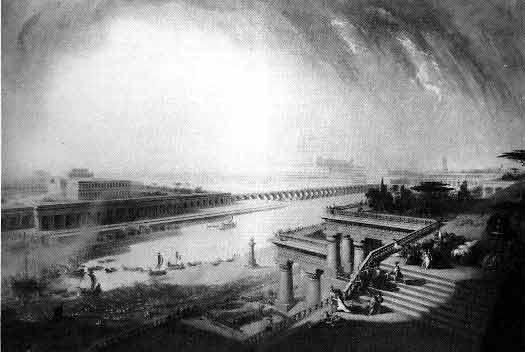Provolution
Sage of Quatronia

The Painting Above hangs in the Japanese State Museum in the Major Palace in Fanatikku.
Originally "The Fall of Babylon", painted 1819, by John Martin, 1789-1854
Civilization III: Civilization Intelligence Reports
The Babylonians
Profile
Leader: Hammurabi
Characteristics: Scientific & Religious
Special Unit: Bowman
Aggression Level:
Favorite Government: Monarchy
Shunned Government: Despotism
Culture Group: Mid Eastern
City Production Emphasis: Science, Culture
Default Color:
Alternate Color:
Babylonian Cities
* Babylon
* Ur
* Nineveh
* Ashur
* Ellipi
* Akkad
* Uruk
* Eridu
* Samarra
* Lagash
* Kish
* Nippur
* Shuruppak
* Zariqum
* Sippar
* Izibia
* Larsa
* Nimrud
* Zamua
* Khorsabad
* Hindana
* Tell Wilaya
* Umma
* Adab
* Telloh
* Nina
* Ebla
Great Leaders
* Agum
* Sargon
* Sumuabum
* Ashurbanipal
* Naboplasser
* Nebuchadnezzar
Background
HammurabiThe Babylonians are scientific and religious. They start the game with Bronze Working and Ceremonial Burial and build bowmen instead of normal archers.
Because of the historical significance and legendary status achieved by the city of Babylon, the term "Babylonian" is often used to refer to all of the ancient cultures and tribes of Mesopotamia. The oldest known urban and literate culture in the world was developed by the Sumerians in Mesopotamia beginning in the late 4th millennium BC. For centuries, Babylon was an insignificant suburb of the Sumerian capital of Ur until Hammurabi (1792-1750 BC) came to power. Hammurabi unified the bickering Sumerians and Akkadians and created the famous Code of Hammurabi, the most comprehensive code of laws of antiquity with 283 entries covering topics from criminal punishments to family laws. Under Hammurabi, Babylon became the commercial and political center of southern Mesopotamia, but its prestige and wealth made it a target for foreign conquerors. The city and empire would be ruled, in succession, by the Hittites, Kassites, Assyrians, Arameans and Chaldeans.
Under the Chaldean leader Nebuchadnezzar II (605-561 BC), Babylon entered its second golden age, spanning the 7th and 6th centuries BC. Aside from the destruction of Jerusalem and Judah, Nebuchadnezzar II is best known for his efforts to rebuild Babylon and reorganize its military forces, returning it to glory as one of the great cities in the ancient world. The fabled Hanging Gardens were constructed at Nebuchadnezzar's decree, reportedly to help his Median wife overcome her longing for the "mountainous scenery" of her homeland. He also rebuilt the great Temple of Marduk and its ziggurat, collectively known as the Tower of Babel. Following Nebuchadnezzar's death, his successor Nabonidus failed to maintain the skilled Bowmen formations and the massive fortifications of the great city. When the Persians under Cyrus attacked in 539 BC, the capital fell almost without resistance. Babylon remained in Persian hands until Alexander the Great overthrew the Persian Empire. Alexander planned to make Babylon the center of his expanded Hellenic empire; however, he died in Nebuchadnezzar's palace before those plans could be completed. Alexander's empire would not survive his death; after a power struggle among Alexander's generals, Babylon passed to the Seleucid dynasty in 312 BC. The city's importance was much reduced by the building of a new capital, Seleucia, on the Tigris, to which most of Babylon's population was forcibly transferred in 275 BC. In the 2nd century BC Mesopotamia became part of the Parthian empire, and Babylon itself a buffer region between the Parthians and the Roman Empire. By the time of Christ, the city was an extensive field of ruins and largely deserted. In the 7th century AD, Mesopotamia was conquered by Muslim Arabs. Babylon passed into legend, and from that time forward the history of the Babylonian realm is that of Iraq and Iran. The city itself would not be re-discovered until the initial surveys by the British archaeologist C.J. Rich in 1811 and 1817. Major excavation began in 1899, under the auspices of the German Oriental Society, and have continued unabated since, revealing more of the wonders of the lost city of Babylon.
Unique Unit: the Bowman
BowmanSince they were continually being attacked, the Babylonians knew a thing or two about siege tactics. Their on-again, off-again relationship with the Assyrians taught them the value of armored, yet maneuverable archers. Babylonian bowmen wore tunics of scale mail armor and helmets, and carried a composite bow that allowed them to strike targets from a long range (though not very accurately). The Babylonians also used cavalry and chariots, but the bowmen corps were the dominant force in their army.
The Bowman is a more armored version of the archer that other civilizations can build. This increased defense makes the Bowman a very useful combat unit, both as an aggressor and as a defender.
Attack Defense Move
Standard Archer 2 1 1
Babylonian Bowman 2 2 1
* end of report *

 If it was a joke, take it easy
If it was a joke, take it easy